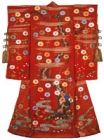Japanese Gallery (Honkan) Room 9
February 20, 2007 (Tue) - April 22, 2007 (Sun)
Kabuki was a popular form of entertainment among commoners during the Edo period (1603-1868). Each season began in the eleventh month of the lunar calendar, so theaters presented kaomise kyogen (face-showing drama), which introduced the actors who would appear on stage for the next year. Kaomise banzuke (pamphlets with actors' portraits) were published, and many people visited the theaters.
Kabuki was established in the early Edo period by a woman named Izumono okuni at the Shijo River in Kyoto. It initially became popular as a kind of review or operetta performed by courtesans and beautiful young boys, but eventually changed to the present style that is performed by only adult males. Kabuki's spreading popularity reached the warrior class to the point where even ladies who worked in o-oku (living quarters for the shogun's wife and consorts) secretly visited the theaters. When an affair between one o-oku woman named Ejima and the actor Ikushima of Yamamuraza theater was exposed, the couple was sent into exile separately. Following this, it became extremely difficult for women from the warrior class to openly enjoy kabuki. However, for the ladies living deep inside the Edo Castle, their passion for kabuki did not die. After the wife of the actor Nakamura Nakazo became an okyogenshi, a kabuki actress who performs in the o-oku, in 1790 (Kansei 2), an all-female kabuki theater was established in o-oku, where no man except for the shogun was allowed.
The kabuki costumes featured here were used by an okyogenshi named Bando Mitsue. She was an actress favored by Renshoin(1785-1861), wife of Hosokawa Naritatsu, and Omiyo-no-kata (-1872), consort of the 11th shogun Ienari. Dating from the late Edo period, these costumes are marked by gorgeous decoration of thick and dynamic embroidery, large design motifs, and rich colors.

